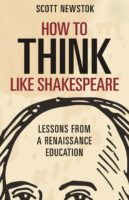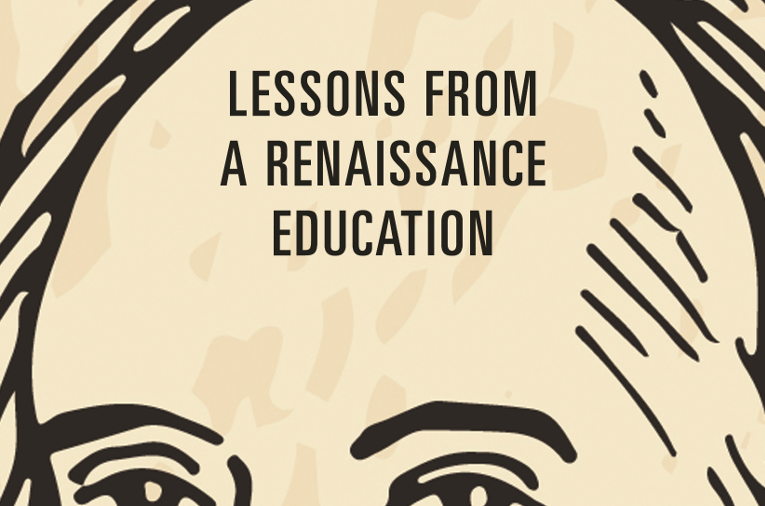 Excerpted from HOW TO THINK LIKE SHAKESPEARE: LESSONS FROM A RENAISSANCE EDUCATION by Scott Newstok . Copyright © 2020 by Princeton University Press.
Excerpted from HOW TO THINK LIKE SHAKESPEARE: LESSONS FROM A RENAISSANCE EDUCATION by Scott Newstok . Copyright © 2020 by Princeton University Press.
WHAT’S PAST IS PROLOGUE
[Shakespeare] almost every where manifests a perfect knowledge in the anatomy of the human mind.—Elizabeth Griffith, The Morality of Shakespeare’s Drama Illustrated (1775)
In this book of short—deliberately short—chapters, I explore what seem to me to be the key aspects of thinking, and how to hone them. As both a teacher and a parent of school-age children, I’ve become dismayed by the way we think of thinking. While dismay first animated my writing, I’m hopeful that Shakespearean habits of mind can help us hold a mirror up to current dogma.1
Anxiety about education suffuses our moment. What’s the purpose of education? Who gets access to it? When and where should it take place? How can we measure it? Will it get us a job? And is it even worth it, when it’s both expensive and time-consuming?
Our anxieties derive from many urgent sources, and surge along many rivulets. But underlying them all lies a worrisome muddle about what we even mean by “education.”
My conviction is that education must be about thinking—not training a set of specific skills.
Education isn’t merely accumulating data; machines can memorize far more, and far less fallibly, than humans.
(Albert Einstein: The value of an education . . . is not the learning of many facts but the training of the mind to think something that cannot be learned from textbooks.)2
Nor is education merely implementing formulas; machines can execute far more complex algorithms, and at speeds no human can aspire to. (Niels Bohr: No, no . . . you are not thinking; you are just being logical.)3
Thinking, that elusive yet crucial activity, is different from these. And if humanity has a killer app, this is it. Conversely, the failure to cultivate thinking is a potential killer. Faced with existential crises in the environment, human migration, creeping authoritarianism, and the specter of artificial intelligence, a world without a broadly disseminated capacity for thinking is severely exposed.
Who better embodies a fully deployed mind than William Shakespeare, whom we can almost watch . . . at the task of thinking?4 Hence the aim of How to Think like Shakespeare. It seeks to offer not only an exploration of thinking, but an enactment of it, for joy’s soul lies in the doing.5
And because the educational assumptions that shaped Shakespeare were at odds with our own, this book explores those assumptions too.
Now, building a bridge to the sixteenth century must seem a perverse prescription for today’s ills.6 If you had to be at your desk by 6:00 in the morning, you too would be creeping like snail / Unwillingly to school. Raise your hand if you’d like to be beaten for tardiness. What—no takers? OK, how about translating Latin? . . .for almost twelve hours a day? . . . for six days a week? . . . with no summer vacations? No wonder that when school broke up you’d hurr[y] towards [your] home.
This education was nasty, brutish, and long. Indeed, it was scorned—by Shakespeare himself! Whether it’s the huffing Holofernes, the garrulous Gerald, or the schoolmaster Hugh Evans (whose monotone repetition of William . . . William anticipates Ben Stein’s Bueller . . . Bueller), Shakespearean teachers come off as domineering pedants, overstuffed with bookish theoric. Even Prospero faults himself for loving the liberal arts so much that he neglected worldly ends.7
You’d have a hard time designing a system more unlike our own student-centered, present-focused, STEM-driven schools. Moreover, the sixteenth-century exclusion of girls, the poor, and cultural minorities affronts our conviction that truth must be common to all.8 We do not want art for a few, any more than education for a few, or freedom for a few.9
Just to be clear: I’m not proposing that we reinstate corporal punishment, tedious rote memorization, or schools that exclude anyone. Thinking is the common property of all.10
Yet it’s blinkered to dismiss Shakespeare’s instruction as nothing but oppressive. Thinkers trained in this unyielding system went on to generate world-shifting insights, founding forms of knowledge—indeed, the scientific method itself—that continue to shape our lives. An apparently inflexible program of study induced liberated thinking. And we’re far from immune from our own inflexible idols: our educational system is too often rigid where it should be yielding, and lax where it should be rigid.11
Thinking like Shakespeare untangles a host of today’s confused—let’s be blunt: just plain wrong12—educational binaries. We now act as if work precludes play; imitation impedes creativity; tradition stifles autonomy; constraint limits innovation; discipline somehow contradicts freedom; engagement with what is past and foreign occludes what is present and native.
Shakespeare’s era delighted in exposing these purported dilemmas as false: play emerges through work, creativity through imitation, autonomy through tradition, innovation through constraints, freedom through discipline.13 I stand with the contrarian view that to be a political progressive, one needs to be an educational conservative. Preserving the seeds of time enriches the present—call this heirloom education:
For out of old fields, as people say,
Comes all this new grain from year to year; And out of old books, in good faith,
Comes all this new knowledge that people learn.14
Each of the following fourteen chapters weighs lessons from Shakespeare’s world (and work), aligns them with modern-day analogues, and suggests opportunities for further reading. Distilled here are the ingredients of this manner of thinking—a kind of loose recipe for cooking it up.
Because the investigation of words is the beginning of education,15 we’ll often pause to ponder the history of a key term, in hopes of amending the impoverished way we’ve come to talk about one of the richest human endeavors. A more vibrant vocabulary could help make a better platform of teaching, to invoke one seventeenth- century educator’s evocative phrase.16 A platform ought to raise us up, not just sell us stuff: And here I build a platform, and live upon it, and think my thoughts, and aim high.17
Throughout this book, I’ve stitched together an almost endless collection of scattered thoughts and observations18 into a kind of patchwork, or cento, of passages that have inspired me.19 Be forewarned: quotations come “swift as thought,” as Homer used to say.20 I do this precisely because thinking like Shakespeare means thinking with each other’s / harvest.21 And I’m eager for this eclectic chorus of voices to be the cause that wit is in other[s]. 22
Little that I say here is new. But if it’s true that there is nothing worth thinking but it has been thought before, then it’s also true that we must only try to think it again.23 And not just think—but restate for our moment: We have now sunk to a depth at which the restatement of the obvious is the first duty.24
The chapters return to recurrent notions, trusting that thought does not progress in a single direction; instead, the moments are interwoven as in a carpet.25 Anything more direct would betray our myriad-minded Shakespeare.26
The reason the chapters are no more than fourteen? To paraphrase King Lear: Because they are not fifteen (1.5.31). In other words: it’s pretty arbitrary!
But in the spirit of the Renaissance fascination with numerical lore, let’s play out a few happy congruences (see chapter 4, “Of Fit”). Fortuitously, fourteen aligns with the number of lines in a sonnet (see chapter 12, “Of Constraint”), the stages in the educational Progymnasmata (see chapter 9, “Of Exercises”), and the US constitutional amendment guaranteeing citizenship (see chapter 14, “Of Freedom”).
Fourteen years is around the age when a student (see chapter 1, “Of Thinking”) left grammar school (see chapter 5, “Of Place”) after copying good models (8, “Of Imitation”) and building up a storehouse of knowledge (11, “Of Stock”). It was the age to enter an apprenticeship (3, “Of Craft”) and start a career (13, “Of Making”). For women in particular, the age stood as benchmark for maturity (2, “Of Ends”), as for Juliet, who we’re reminded hath not seen the change of fourteen years,27 or in the case of Pericles’s fourteen-years-delayed reunion with his daughter Marina (10, “Of Conversation”).
The Greek mathematician Archimedes (7, “Of Technology”) invented a puzzle called ostomachion, which sharpened your memory (6, “Of Attention”) while you rearranged its fourteen pieces into patterns of infinite variety.28 And many religious traditions find the number significant: Jains believe in fourteen levels of spiritual development; Catholics observe fourteen stations of the Cross; the Passover Seder follows fourteen steps.
More poignantly, the Egyptian god Osiris was said to have been cut into fourteen pieces by his murderous brother Set, who scattered the bits in all directions. John Milton transformed this mythological butchery into a parable about the laborious process of reconstructing thought:
From that time ever since, the sad friends of Truth, such as durst appear, imitating the careful search that Isis made for the mangled body of Osiris, went up and down gathering up limb by limb, still as they could find them.
Milton concedes: We have not yet found them all . . . nor ever shall do.29
That’s all the more reason to think hard about thinking.
Endnotes
1 This section’s title derives from The Tempest (2.1.246)—but reader beware: in its original context, this is an incitement to murder! Unless otherwise noted, all Shakespeare quotations derive from The Norton Shakespeare, 3rd ed., edited by Stephen Greenblatt et al. (Norton, 2016).
2 According to his biographer, this was Einstein’s 1921 retort to Thomas Edison mocking college as “useless.” Philipp Frank, Einstein: His Life and Times, trans. George Rosen, ed. Shuichi Kusaka (Knopf, 1947), 185.
3 As reported by Otto Robert Frisch, What Little I Remember (Cambridge University Press, 1979), 95.
4 E. E. Kellett, “Some Notes on a Feature of Shakespeare’s Style,” in Suggestions (Cambridge, 1923), 57–78. I’ll confess: I found this quotation in Sister Miriam Joseph’s still-wonderful Shakespeare’s Use of the Arts of Language (1947; Paul Dry Books, 2008), 169. Her study The Trivium (1948) remains a gem as well.
5 Troilus and Cressida (1.3.265).
6 I’ve lifted this phrase from Neil Postman’s Building a Bridge to the Eighteenth Century (2011). His Amusing Ourselves to Death (1985) was the most unsettling book I stumbled upon as a teenager in the Duluth Public Library. Among the many publications with the doomsayer title The End of Education, my favorite remains Postman’s (1996).
7 Whew! that was a mint of phrases: As You Like It (2.7.144–46); 2 Henry IV (4.2.271– 72); The Merry Wives of Windsor (4.1.14–64); Love’s Labor’s Lost (3.1.163); Othello (1.1.22); The Tempest (1.2.73, 89); Love’s Labor’s Lost (1.1.163).
8 Mary Wollstonecraft, “Dedication,” in A Vindication of the Rights of Woman ( James Moore, 1793), vi.
9 William Morris, “The Lesser Arts,” in Hopes and Fears for Art (1877; Longman, 1930), 35.
10 Heraclitus, ξυνόν ἐστι πᾶσι τὸ φρονέειν, cited by Haun Saussy, “A Backstage Tour of the Palace of Culture,” History of Humanities 4, no. 1 (Spring 2019): 62.
11 Alfred North Whitehead sounds as if he could just as easily be writing today as a century ago. The Aims of Education (1916; The Free Press, 1967), 13.
12 As Thomas Paine jabbed in 1776: a long habit of not thinking a thing wrong, gives it a superficial appearance of being right. Common Sense, and Other Writings, ed. Gordon Wood (Modern Library, 2003), 5.
13 Jeanette Winterson goes so far as to say that no discipline equals no freedom. “Ten Rules for Writing Fiction (part two),” Guardian, February 19, 2010.
14 Katharine Birbalsingh, Headmistress at Michaela Community College, 2012 Learning Without Frontiers conference, https://www.youtube.com/watch?v=pJx EM_i3iXo. Macbeth (1.3.59); Geoffrey Chaucer, The Parliament of Fowls (1:22–25), as modernized by Harvard Law School, and a favorite quotation of British jurist Edward Coke.
15 Antisthenes, Artium scriptores, ed. L. Radermacher, B.19.6.
16 Charles Hoole, The Usher’s Duty; or, a Platform of Teaching Lily’s Grammar (1637).
17 Mary Oliver, Long Life (Da Capo Press, 2004), 90.
18 Jean-Jacques Rousseau, Emile, or On Education (1762).
19 Even saying that isn’t new—just listen to Michel de Montaigne: I have gathered a posie of other men’s flowers, and nothing but the thread that binds them is mine own. Essays of Michel de Montaigne, “Of Physiognomy,” cited by Willis Goth Regier, Quotology (University of Nebraska Press, 2010), 107. As Regier notes, John Bartlett liked this quotation so much that he made it the epigraph to the fourth and subsequent editions of his Familiar Quotations (Little, Brown and Company, 1863).
20 Hannah Arendt, “Thinking and Moral Considerations,” Social Research 38, no. 3 (Autumn 1971): 431.
21 Gwendolyn Brooks, “Paul Robeson,” in Family Pictures (Broadside Lotus Press, 1971), 19.
22 2 Henry IV (1.2.9).
23 Johann Wolfgang von Goethe, Maxims and Reflections, trans. Bailey Saunders (Macmillan, 1893), 59.
24 George Orwell, in a review of Bertrand Russell’s Power: A New Social Analysis, in Adelphi, January 1939.
25 Theodor Adorno, “The Essay as Form,” in Notes to Literature (1958; Columbia University Press, 1991), 13.
26 Samuel Taylor Coleridge, Biographia Literaria, ed. J. Shawcross, 2 vols. (Oxford University Press, 1901), 2:13.
27 Romeo and Juliet (1.2.9).
28 Antony and Cleopatra (2.2.248).
29 Areopagitica (1644), in The Complete Poetry and Essential Prose of John Milton, ed. William Kerrigan, John Rumrich, and Stephen M. Fallon (Modern Library, 2007), 955.





